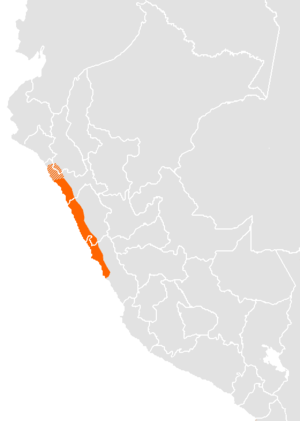Quingnam language
| Quingnam | |
|---|---|
| Native to | Peru |
| Extinct | 16th century? |
|
unclassified | |
| Language codes | |
| ISO 639-3 |
None (mis) |
| Glottolog |
quig1235[1] |
|
Extent of Quingnam/Pescadora before replacement by Quechua and Spanish | |
The Quingnam language is a pre-Columbian language of the area that is believed to have disappeared before the beginning of the Inca Empire. Quingnam was spoken by ethnic Chimú, who lived in the former territories of the Mochicas: an area north of the Chicama Chao River Valley. At the height of Chimú conquests, the language was spoken extensively from the Jequetepeque River in the north, to the Carabayllo (near present-day Lima) in the south.
Fishermen along the Chimú coast spoke a language called Lengua Pescadora (fisherman language) by Spanish missionaries, and disambiguated as Yunga Pescadora by linguists; this may be the same as Quingnam. A letter found during excavations at Magdalena de Cao Viejo in the El Brujo Archaeological Complex includes a list of decimal numerals which may be Quingnam or Pescadora, but they are not Mochica.[2]
The Quingnam language became extinct shortly after the arrival of the Spanish conquistadors, primarily due to:
- The core Chimú city, Chan Chan, was in the vicinity of the new Spanish city of Trujillo and became overwhelmed by it, with people needing to pick up the language of the conquerors for trade and survival.
- People abandoned Quingnam after learning to speak a Spanish dialect.
- The area of transmission was much smaller than that of the Mochica language: Quingnam was only spoken by the elite Chimú in territories belonging to the Chimú empire. Quingnam was spoken in Tumbes, Piura and parts of Lambayeque (also inhabited by Mochica-speakers). Quingnam was spoken overwhelmingly in the coastal strip from Jequetepeque to the Huaral River (present-day Ancón). Some estimates are that the language was spoken on the coast as far south as the river Chillón (Carabayllo).
- Most speakers were killed by infectious disease epidemics; the Spaniards carried diseases to which the natives had no immunity.
- The surviving Quingnam speakers were uprooted from their native places, as indigenous people were bought by the Spanish for laborers. They were taken to work on estates and obrajes.
See also
References
- ↑ Nordhoff, Sebastian; Hammarström, Harald; Forkel, Robert; Haspelmath, Martin, eds. (2013). "Quignam [sic]". Glottolog. Leipzig: Max Planck Institute for Evolutionary Anthropology.
- ↑ "Traces of a Lost Language Discovered". Peabody Museum of Archaeology and Ethnology at Harvard University. August 23, 2010.
